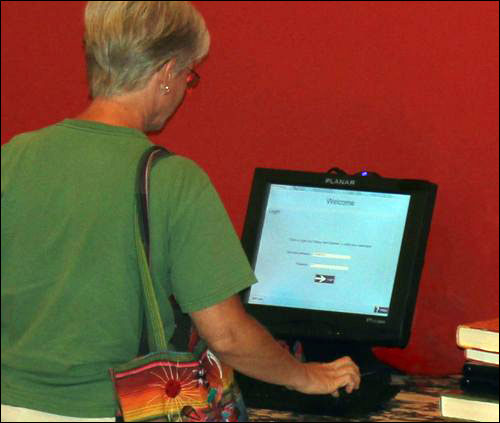After years of research and development, Grand Rapids Public Library has launched a radio frequency identification system this month, intended for all eight of its branches. A few weeks ago, patrons of the Michigan library’s main branch began using RFID to check in and out the books and other materials they borrow. However, the library expects to install a more expansive RFID system at all eight branches, with the goal of reducing labor costs and improving efficiency. The technology consists of fixed and handheld readers, tags on all media, and software designed by the library’s IT department to manage RFID read data and integrate it with the existing library-management system. The encoded and printed EPC Gen 2 ultrahigh-frequency (UHF) labels and readers, as well as software to link read data to the library’s system, is provided by Michigan RFID firm eAgile.
Grand Rapids believes it is the first public library in North America to adopt UHF RFID. Most libraries around the world that have implemented RFID technology are employing high-frequency (HF) passive tags (HF is currently an accepted standard for libraries), with the tags read at a short read range at checkout counters. Typically, however, libraries require a separate security system to track media leaving through the exit, since HF tags have a short read range, or they must install a large antenna array specifically designed to read HF tags passing through a portal.

By opting for UHF, says Gary Burns, the CEO and cofounder of eAgile—which sells both HF and UHF RFID library solutions—a library can attain an RFID system that works faster and more efficiently, takes up less space and costs less. For instance, Grand Rapids Public Library can automate the receiving of checked-out books (with an RFID reader in the return chute), manage checkout more quickly (a pile of books can be read simultaneously) and provide a security gate that not only interrogates the tags of any unchecked-out items being removed from the library, but also identifies those items for the staff. In addition, the system enables employees to locate or inventory books in stacks using a handheld reader or a portable interrogator on a wheeled cart.
After conducting several years of research into HF solutions, says Marla Ehlers, Grand Rapids Public Library’s assistant director, the facility determined that they were too expensive or limited in what they provided. Ehlers discovered eAgile, which offers what it calls the BookSmart ID system. The product, Burns says, includes fixed and handheld readers manufactured by eAgile; UHF labels that eAgile obtains from a variety of vendors, and then encodes and prints for customers; and a BookSmart application protocol interface (API) to link RFID data to the customer’s database.With the new system in place, eAgile encodes and prints RFID labels for each book and other media drawn from the library’s catalog. Grand Rapids Public Library provided eAgile with catalog information shelf by shelf, and eAgile created a set of RFID labels for every shelf, with a label printed with a human-readable tag ID number and a title for each item on that shelf. According to Ehlers, the unique ID encoded to a label’s RFID inlay is then linked to the library’s own record of that item in its open-source integrated library system (ILS), known as Evergreen, and RFID software developed by the library.
Not only books, but also other items, such as CDs and DVDs, are being tagged. In the case of items with multiple discs and a cover, an RFID label is being applied to the cover and married in the software with the tag ID numbers of the labels placed on each disc. In this way, an interrogator could capture all tag IDs at once, without the case being opened, thereby ensuring that all discs are present when an item is checked out or in.
Upon collecting all books or items to be checked out, a patron proceeds to the checkout counter, under which an eAgile reader is installed. The visitor uses a bar-code scanner to scan his or her library card, then places the entire stack of books or other materials on the counter above the reader. Because UHF tags have a considerably longer read range than HF tags, the device can capture the ID numbers of multiple items in a single stack without requiring that they be scanned at close range. This technology is already in use at the library’s main branch, with other branches expected to go online this year as well.
At present, employees are still applying the tags to the material at all of the branches, and thus only the checkout portion of the deployment, within the main branch, is complete. However, the library is currently beta-testing technology to provide further functionality.For example, if a specific book is needed from the shelf, a patron may search for that title and, if unable to find it, request help from the staff. Workers could then utilize one of the handhelds to look up the book’s location in the Evergreen software (in some cases, books are relocated according to season—such as Halloween books, or new releases). If the book is found not to be where the software indicates it should be located, employees can use the handheld’s Geiger-counter mode to walk through the stacks and pinpoint it.
With other functionality, a patron leaving the library walks through a security gate, at which time another eAgile reader captures the ID of every tagged item that individual is carrying, and the Evergreen software searches whether each has been checked out. If a tag is identified for an item that has not been checked out, an alert is issued to the security gate and an audible tone is sounded, along with a flashing red light, while staff members see a display in the software indicating which item has set off the alarm.
Another part of the system is the check-in process. With the use of RFID, a book, once returned, will be dropped into a return chute, at the end of which a reader captures that item’s ID number. The Evergreen software then updates its status as having been returned, and also searches the item’s records to ensure that it has not been reserved for another patron. In the event that such a reservation is indicated, an alert would be sent to the staff to retrieve the item and set it aside, rather than putting it back on the shelf.
The solution will also include an RFID reader on a cart that could be used for inventory checks, Ehlers says. Such a device, consisting of the cart itself, a reader and a laptop computer, could be wheeled down the center aisle of each set of shelves, in order to identify all books within that area. Although eAgile also offers a product known as the Inventory Roamer Cart, the library already has RFID-reading hardware that will enable it to build such a cart itself.
However, Ehlers says, the technology has certain limitations. For example, some books may be covered with a layer of metallic foil, which can block the RF signal and, thus, require special accommodations, such as cutting a piece of the cover away to enable transmission. Burns says eAgile is also developing a cost-effective on-metal tag that, in the future, could be used in such scenarios.


